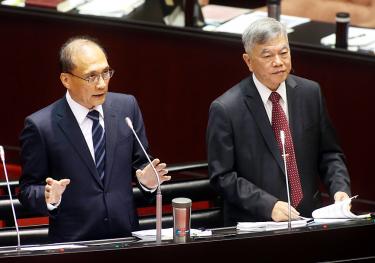Spare nuclear power can be tapped to ensure a stable power supply in the event of an emergency, Premier Lin Chuan (林全) said in an interview published yesterday as he reaffirmed the government’s energy transition goals.
Although the government plans to phase out nuclear power, a reactor at the Guosheng Nuclear Power Plant could be reactivated when necessary, Lin said in an interview with the Chinese-language Liberty Times (sister newspaper of the Taipei Times).
“Although [the reactor] is not considered part of the operating reserve, I would make a formal report to the Legislative Yuan to reactivate it as a last resort in the event of a predictable power shortage. The manufacturing industry should have confidence in the power supply,” Lin said.
However, he reaffirmed the government is committed to phasing out nuclear power while boosting natural gas-generated power and renewable power to 50 percent and 20 percent of the total power generation respectively, and reducing coal-fired power to 30 percent by 2025.
“Taiwan has few natural resources and there are problems with either nuclear power, coal-fired power or natural gas-fired power. We have to make a choice, but nuclear power is too dangerous. The nation would be endangered in case of a nuclear disaster,” he said.
Pressed by reporters about Lin’s comments, Executive Yuan spokesman Hsu Kuo-yung (徐國勇) yesterday said that the reactor would only be used as a last resort to maintain an adequate power supply.
“Unless there is no other way to keep power from running short, there are no safety concerns, and society agrees to reactivate the idle nuclear reactors, the reactors at the first and second nuclear power plants will not be restarted,” Hsu said.
The shutdown of a power plant in Hualien County after a typhoon last month downed a transmission tower resulted in contingency energy-saving measures, and the malfunction of a power plant in Taoyuan that caused a massive outages around the nation on Aug. 15 have pointed to grid management problems, not the need for nuclear power generation, Lin said.
The Democratic Progressive Party, shortly after it won the general elections last year, told Taiwan Power Co (台電) to plan an electricity supply scheme without extending the lifespan of the nation’s three active nuclear power plants or activating the mothballed Fourth Nuclear Power Plant, Lin said.
Wind and solar power and a stable grid storage system have to be developed to ensure uninterrupted supply in off seasons to achieve such a goal, and a “smart” grid system has to be established to reduce power consumption during peak hours, he said.
The development of solar power, although technically more viable, is limited to land availability, so wind power has more potential than solar power, he said.
Major wind power farms could begin operations in 2020, and they could generate about 3.5 gigawatts (GW) to 4GW by 2025 when all three operating nuclear plants are due to be decommissioned, he said.
It is important to reduce peak hour consumption to maintain stable supplies without building more power plants, Lin said.
A “smart” household meter system would allow users to know real-time consumption and encourage them to adopt a flexible electricity pricing system, which demands a high rate during peak hours while offering during off-peak times.




